
Tiny fish bones, button-like seashells, cicada wings, rattlesnake ribs, fairy duster seeds — nature’s discards are the very lifeblood of material for longtime Arizona artist Mayme Kratz, who lovingly collects these items by the hundreds and then incorporates them into her cast resin pieces. Her homages to desert flora and fauna altogether seem like a reverent tribute to the inherent beauty of the natural world at its most elemental level. For instance, “Until I am Dust” preserves an actual bloom from the huge agave plant, with all its botanical details intact, on a large ink-painted panel, with a closer look revealing feathers and rattlesnake ribs in the resin.
But then there’s that collection in the center of the gallery. Titled “BP (Brown Pelican) Numbers 1 through 5,” they are five separate works, each consisting of an oblong, translucent, jewel-toned box encasing the mold of a brown pelican’s neck bone. Each neck bone is slightly different. They are not as pretty or ethereal as the dozen or so other works, but they are certainly more political. As a celebrator of the natural world, Kratz makes a laudable gesture with this simple and somber memorial of one of the many bird species ravaged by last summer’s BP (British Petroleum) oil spill.
In fact, Kratz departs from previous exhibitions by looking at the antithesis of the desert, the ocean, and its artifacts of fish bones and shells. A standout work in this regard is the 16-inch square “Fish Moon,” which is like an ivory medallion with the prized “ivory” instead being a collection of tiny fish bones. Who knew fish left behind such interestingly shaped remains? Kratz helps us reassess the definition of beauty. Similarly, “Across the Velvet Dark” scatters small, non-descript shells on a deep ocean-green resin background as if they were pearls caught in an eddy. In this work and others, Kratz devotes attention to the surface under the resin, giving it painterly touches of swirling and dripping color.
Kratz also broadens her horizons with “Falling Leaf,” where for the first time she pairs the actual element of nature that first caught her attention — a decaying but carefully preserved cottonwood leaf — with her representation of it. In this case, it’s hundreds of ring-like fairy duster seeds meticulously arranged to resemble the humble leaf and then preserved in resin. A smaller work, “Middle Night Song,” brings together two images: fairy duster seeds on an indigo background that could be mistaken for a slide of cells under a microscope, along with delicate cicada wings in a pattern resembling a helix. Context is everything when considering the value of foliage droppings or insect remains.
Kratz’s work exerts a spiritual resonance, reacting as it does to that majestic force responsible for the patterns and shapes in nature that repeat themselves across species and through time. The seeds, skeletons and infinite debris of the natural world are easy to overlook as merely part of the background until someone like Kratz brings them forcefully to our attention.
Also worth a look are “Portraits of Transformation,” photographs by Jo Whaley in which brightly colored butterflies appear to eat away at antique family portraits.
